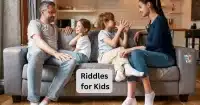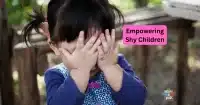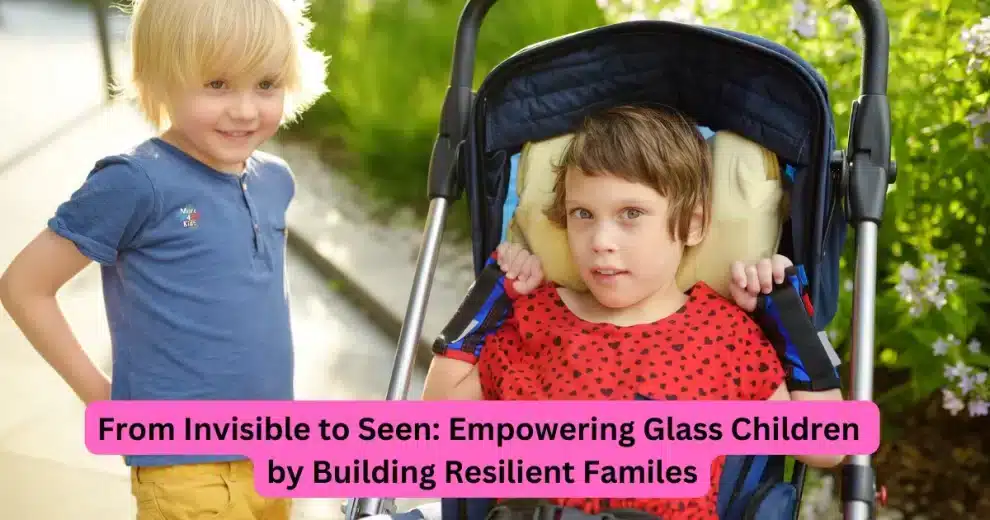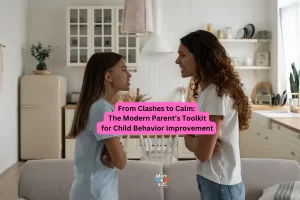Strengthening and Empowering Glass Children by Building Resilient Families
Table of Contents
The room is dimly lit, typical for the rooms in the hospital; lying in bed is a young child who has been disabled for life and has frequent hospitalizations. The room is bustling with activity centered on the child in bed. Yet, sitting in the corner is another child, legs crossed, quiet, reading a book – but not saying a word – as the conversation between the medical professional and parents continues.
A second scenario might be quite different; the child lying in bed is repositioned, covered, and cared for by a young sibling. The sibling appears to be perfect – mature beyond their age, kind and caring toward their disabled brother or sister: a much-needed caregiver for the over-stressed parents of a disabled child.
As a pediatric nurse, I frequently observe the siblings of children who are disabled or chronically ill. This sibling – the healthy child – has come to be commonly referred to as “The Glass Child.”
In both of these and similar scenarios, the children’s parents are very attentive to their special needs child, but often fail to see the difficulty their normal or healthy child is experiencing. The child sitting quietly or being overly attentive and behaving as a “good” child has learned not to cause problems for their stressed, tired parents, and the child is often overlooked.
Create a Brighter Future for a Child

There is no intent here to condemn, but rather to bring awareness of a significant issue and to instill hope in a child’s life. For the purposes of this discussion, “special needs” are defined as any characteristics of a dependent child that abnormally consume the parent’s time: it can be cases where the child is disabled, chronically ill, suffering from a mental illness, or even a drug-addicted child.
Together we can make a difference in the life of every glass child. Let’s bring about the change first through awareness, then action.
What is Glass Child Syndrome?
Glass Child Syndrome, also called the “invisible sibling syndrome,” is a psychological condition in which siblings of special needs, disabled or chronically ill child often feel neglected. They are called “glass children” because they can see the needs of their disabled siblings, just as everyone around them can, but feel that their own needs are somehow invisible to their parents.
Awareness of the Glass Child
The Glass Child term was brought to light in 2010 by Alicia Maples (formerly Arenas) during her TED talk, as she described growing up with a brother with Autism. She outlined a life that many of us cannot even imagine.
“We are called ‘glass children,’” Maples explained, “because our parents are so consumed with the needs of our brothers and sisters that when they look at us, they look right through us as though we’re made of glass.”
This syndrome expresses the often overlooked emotional and psychological toll that siblings of kids who are disabled may experience. It can be difficult for these children to reconcile the differences between their siblings and themselves, leading to feelings of guilt or inadequacy for the “normal” child.
The siblings will often feel guilty because they are normal, yet their disabled sibling is not, perhaps even asking themselves, “Why was I born normal?” Then, adding to the difficulty, there are feelings of inadequacy due to the constant striving to be the perfect, well-behaved, good child for their parents – maybe even good enough to make everything alright – which is simply an unattainable goal. They expend even more energy and emotion by defending and caring for their special needs sibling. Together, these very common thought patterns create an emotional roller coaster effect for the child.
TikTok Brings Awareness
This phenomenon was not just brought to light by Maples, but also by countless other sibling children and adults who tell the good and the bad experiences of growing up with a disabled sibling on TikTok.
With over 70 million views, TikTok continues to bring the experiences to the frontline on what life is like with a disabled sibling through the #glasschild, #glasschildsyndrome, and #wellchildsyndrome.
The Countless Siblings: An Invisible Population
It is hard to calculate how many siblings of children that are disabled exist, but the numbers are likely very high. The World Health Organization states that an estimated 1.3 billion people – or 16% of the global population – are disabled. This number tells us that there are likely a lot of siblings of disabled individuals.
United States Disability Statistics
In the United States, an estimated 17% of children have one or more developmental disabilities, which would show a significant amount of young people likely have a sibling that is disabled or chronically ill.
United Kingdom Autism Study
According to a study on autistic children living in the United Kingdom (UK), about 1% of the population has an autistic diagnosis. When you look at family members, autism diagnosis affects about 2.8 million people within the UK.
As these statistics highlight the vast number of siblings of disabled individuals worldwide, it becomes evident that supporting and empowering these “glass children” is crucial for fostering a more inclusive and compassionate society.
Characteristics of a Glass Child
Unlike the name, this child is not fragile like glass. They appear to be mature, helpful caretakers, often exceeding in school and acting as the good, perfect child.
“Glass children take on these caretaker responsibilities, and naturally, we are conditioned not to have any problems,” Maples said. “We are supposed to be perfect. When someone asked us how we were doing, the answer was always: I’m doing fine.”
The effects of glass child syndrome can look quite different when you look closely at this sibling. The strong exterior is often masking a child with feelings that can include depression, anxiety, difficulty forming relationships, guilt over feeling jealous of the attention their disabled sibling receives, and feeling overwhelmed.
Life with an Autistic Sibling
The study on siblings of Autistic children showed that a sibling of an autistic family member reported fewer extracurricular activities at school, possibly due to the role of caregivers that many siblings take on, along with perceived lower school belonging and academic self-concept. Many of them also reported poor sleep cycles, negative mornings, and ineffective homework routines due to a disruption; other situations could also arise, adding to the negative feelings of a sibling.
Behind the Facade
Behind their seemingly resilient façade, glass children bear the weight of unspoken challenges, grappling with many emotions and navigating complex roles within their families. Recognizing their struggles and providing them with the support and understanding they need can empower these remarkable siblings to flourish and thrive.
Recognizing the Signs of Coping Difficulties
Not all children will show these signs, and many work hard to cover up their feeling, but according to the American Academy of Pediatrics, the following could be warning signs that your child is struggling:
· The child is anxious.
· They appear to be withdrawn.
· Your child is frequently exhibiting anger.
· The child seems to be losing interest in friends or activities they once enjoyed.
· The child is not doing well in school.
· The child is pushing too hard to do well.
· Your child is behaving rebelliously.
· Your child is “acting out” to get parental attention.
Be aware that not all traits are negative; these are signs that action should be taken to assist your child.
Positive Effects of Having a Disabled Sibling
Studies have also shown that a child with a special needs sibling may develop more cognitive empathy – demonstrating the ability to understand others’ emotions compared to those children without a special needs sibling.
Transforming Lives: Improving Your Family Dynamics
Many children are afraid to disclose their negative feelings and become experts at stuffing their thoughts so as not to overstress their already stressed parent. They feel that meeting their needs is unimportant or is secondary to their family.
Some children even distance themselves, which can cause an intensity of negative feelings. Maples described a point in her childhood when she was seriously contemplating suicide, yet no one was aware of the deep depression and suicidal thoughts that she was having.
What can you do as a parent to strengthen and improve your family dynamics?
· The most important thing a parent can do is talk to their healthy child – frequently. Realize that it might take time before the child shares their deepest feelings.
· Let them know that they can share these feelings and that you also have thoughts or feelings that are difficult at times.
· Provide siblings with age-appropriate information. Many adult siblings talk about medical jargon thrown around while they sat at the bedside or at appointments for their siblings and that they never truly understood what was being said.
· Talk to your child about what is going on in terms they can understand.
· Have open family discussions about the illness and its impacts on the family.
· Find age-appropriate medical information about their sibling’s illnesses.
· Remember that this sibling could one day outlive you and become the caregiver – so include them in the family planning.
· Help your child find the support and care they need.
· Find supportive networks for the child with people in similar situations.
o The Siblings Network can be a great resource.
o Camps for siblings
o Charlie Health offers a virtual outpatient program for kids.
· Show them that you love them unconditionally – not just for their assistance with their sibling, but for themselves.
· Give them space and time to find their interests, develop a positive identity, and achieve personal goals outside the other child’s illness.
· Bring in extended family, neighbors, or friends to assist with your child’s support network – remember, it takes a village.
· Do not be afraid to get your child counseling or mental health care – they need an outlet.
· Continue to update yourselves on siblings of disabled children’s challenges. Awareness of this issue can bring change.
The main objective is to surround your child with the support they need, help them find a safe place to express their thoughts, and love them unconditionally so they can learn to cope with the illness and develop into healthy adults.
For the Medical Professional: Improving Your Bedside Skills
Be aware of this syndrome, and when assessing or working with a child with disabilities or chronic illnesses, ask about the family dynamics.
· Are there other children?
· Are there any mental health issues?
· How do they handle the extra parental responsibilities?
· How is the non-disabled child doing?
While in the room, if there is a sibling, take the time to learn their name and explain the medical condition in terms that even that child could understand. Make your work with this family a team approach and include the social worker. Refer to family therapy if needed.
For the Community: It takes a Village
Be aware that there are likely families with disabled children right in your neighborhood or in your child’s school. Look at the family dynamics – is there an overwhelmed parent? Advocate for them by seeing how you can help. Can you carpool their healthy child to school activities, bring a meal, or volunteer for other family needs?
Closing Thoughts

Awareness, open communication, and support are essential to address their emotional needs. Parents should engage in regular conversations, provide age-appropriate information, and involve their healthy child in family planning.
Medical professionals should consider family dynamics and involve siblings in discussions. As a community, we can offer support, recognize signs of distress, and advocate for these families. Together, we can create a compassionate and inclusive environment where no glass child feels unseen or unheard.
Ultimately, it is crucial to remember that every child deserves to be seen, heard, and supported, regardless of their health condition. By working together and taking action, we can bring about positive change and ensure that no glass child feels invisible or neglected. Let us strive for a future where every child thrives and no sibling is left behind.
FAQ’s
What is a ‘glass child’?
A ‘glass child’ is a sibling of a disabled or chronically ill child. They often feel overlooked as their parents focus on their sibling’s needs.
What emotions do ‘glass children’ typically experience?
‘Glass children’ often grapple with feelings of guilt, inadequacy, depression, and anxiety due to their unique family circumstances.
How can parents support a ‘glass child’?
Parents can support a ‘glass child’ by maintaining open communication, providing age-appropriate information about their sibling’s condition, and involving them in family planning.
What are signs that a ‘glass child’ may be struggling?
Signs of struggle may include anxiety, withdrawal, frequent anger, loss of interest in activities, poor school performance, rebellious behavior, and ‘acting out’.
Are there any positive effects of being a ‘glass child’?
Yes, studies suggest ‘glass children’ often develop greater cognitive empathy, understanding others’ emotions more deeply than those without a special needs sibling.
Why are they called ‘glass children’?
The term ‘glass child’ symbolizes their feeling of invisibility, as if they were made of glass, due to the attention given to their sibling’s needs.
What is Glass Child Syndrome?
Glass Child Syndrome, or ‘invisible sibling syndrome’, is a condition where siblings of a disabled or chronically ill child often feel neglected.
How can communities support ‘glass children’?
Communities can offer support by recognizing signs of distress, advocating for these families, and helping to create a more inclusive and understanding environment.
Are there resources available for ‘glass children’?
Yes, resources such as The Siblings Network, sibling camps, and virtual outpatient programs like Charlie Health offer support and community for ‘glass children’.
What is the ultimate goal for ‘glass children’?
The goal is to ensure every ‘glass child’ feels seen, heard, and supported, fostering a future where no sibling feels overlooked or neglected.
Works Cited
Barrand, R. (2023, January 9). What is a glass child? Meaning explained – plus symptoms of middle child syndrome and youngest child traits. Retrieved from National World: https://www.nationalworld.com/lifestyle/family-and-parenting/glass-child-middle-child-syndrome-youngest-child-traits-3980081
CDC. (2022, May 16). CDC’s Work on Developmental Disabilities. Retrieved from Centers for Disease Control and Prevention (CDC): https://www.cdc.gov/ncbddd/developmentaldisabilities/about.html
Deavin, A., Greasley, P., Dixon, C; Children’s Perspectives on Living With a Sibling With a Chronic Illness. Pediatrics August 2018; 142 (2): e20174151. 10.1542/peds.2017-4151 https://publications.aap.org/pediatrics/article/142/2/e20174151/37553/Children-s-Perspectives-on-Living-With-a-Sibling?autologincheck=redirected
duRivage-Jacobs, S., & Gasparini, D. (2023, February 24). What is Glass Syndrome? Retrieved from Charlie Health: https://www.charliehealth.com/post/what-is-glass-child-syndrome
Hanvey, I., Malovic, A., & Ntontis, E. (2022). Glass children: The lived experiences of siblings of people with a disability or chronic illness. Journal of Community & Applied Social Psychology, 32(5), 936-948. https://www.sciencedirect.com/science/article/pii/S0891422222001536?via%3Dihub
Hastings, G, & Kovshoff, H. (2020). Academic self-concept and sense of school belonging of adolescent siblings of autistic children. Research in Developmental Disabilities, 96, 103519.https://www.sciencedirect.com/science/article/abs/pii/S0891422219301866?via%3Dihub
Ignace P. R. Vermaes, Ph.D. and others, Psychological Functioning of Siblings in Families of Children with Chronic Health Conditions: A Meta-Analysis, Journal of Pediatric Psychology, Volume 37, Issue 2, March 2012, Pages 166–184, https://academic.oup.com/jpepsy/article/37/2/166/1746321?login=false#25702844
Julie. (2023). Growing Up a Glass Child. Retrieved from Special Kids: https://specialkids.co.za/home/siblings/item/700-growing-up-a-glass-child.html
Nebeker, G. (2021, June 1). Glass Children: The overlooked siblings of the people we treat. Retrieved from Integrated Care News by CFHA: https://www.integratedcarenews.com/2021/glass-children-the-overlooked-siblings-of-the-people-we-treat/
Pavlopoulou, G., Burns, C., Cleghorn, R., Skyrla, T., & Avnon, J. (2022). “I often have to explain to school staff what she needs.” School experiences of non-autistic siblings growing up with an autistic brother or sister. Research in Developmental Disabilities, 129, 104323. https://www.sciencedirect.com/science/article/pii/S0891422222001536)
Siblings of Children with Chronic Illnesses or Disabilities. (2015, November 21). Retrieved from American Academy of Pediatrics: https://www.healthychildren.org/English/health-issues/conditions/chronic/Pages/Siblings-of-Children-with-Chronic-Ilnesses.aspx
The Arc. (2018, April 17). How Can We All Help Glass Children. Retrieved from The Arc: https://arcmonroe.org/glass-children-siblings-disabilities/
WHO. (2022). Global report on health equity for persons with disabilities. Retrieved from World Health Organization (WHO): https://www.who.int/teams/noncommunicable-diseases/sensory-functions-disability-and-rehabilitation/global-report-on-health-equity-for-persons-with-disabilities
Wolff, B., Magiati, I., Roberts, R. et al. Psychosocial Interventions and Support Groups for Siblings of Individuals with Neurodevelopmental Conditions: A Mixed Methods Systematic Review of Sibling Self-reported Mental Health and Wellbeing Outcomes. Clin Child Fam Psychol Rev 26, 143–189 (2023). https://link.springer.com/article/10.1007/s10567-022-00413-4













Add Comment